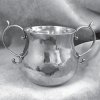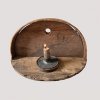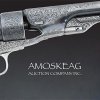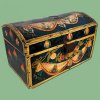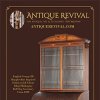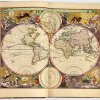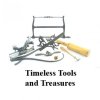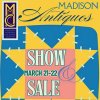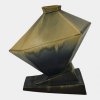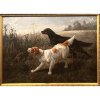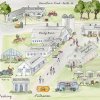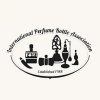Buyers' Market for Vintage Radios, Phonographs, and Related Equipment
November 22nd, 2015
Vintage Radio and Phonograph Society, Mesquite, Texas
The 41st annual Vintage Radio and Phonograph Society (VRPS) convention held in Mesquite, Texas, November 20-22, 2015, was the country’s largest radio club auction of vintage radio, phonograph, and related equipment spanning the pre-World War I windup phonograph to the 1950s miniaturized transistor radio. Out of well over 1000 lots auctioned, nearly 900 vintage radios, related ephemera, horn and cone speakers, amplifiers, single and boxed vacuum tubes, ham radio microphones, cylinder phonographs, telegraph equipment, and early TVs sold for $35,000, a 7% increase over the 2014 convention totals.

The highest bid of the auction and the loudest applause went to a pre-World War II table radio. Unlike most radios of its day, this 1938 five-tube AC-powered burled walnut Stewart Warner table radio Model 91-513, 10" high x 13" wide x 10½" deep, is totally enclosed on all sides in an expensive high-quality Ingraham cabinet designed to command the center of the room. It’s known as the “Spade” radio because two sides of this uniquely triangular-shaped radio resemble an ace of spades. The front ribbed cabinet supports a golden checkered grill cloth covered by repetitive teardrop wood carvings that continue onto the back. On the front right, a dull brass escutcheon holds the dial below which are four preset station buttons—all encased by a brass escutcheon—above control knobs. The original “MAGIC KEYBOARD” decal celebrates the radio’s well-advertised preset tuning feature. Texas collector Ray Inman placed the winning $892.50 bid for this rare radio he’s been wanting for several years. Sally Wilson Smith photo.
The two-day auction, which 30-year collector Bob Lutz calls, “The best-run auction of any U.S. radio club,” attracted 78 registered sellers predominately from Texas and nearby states like Oklahoma, Arkansas, Louisiana, and Kansas. Both Friday and Saturday, sellers unloaded their wares onto long tables in the designated display room behind the partitioned auction area in the Mesquite Convention Center and Exhibit Hall that adjoined the three-star Hampton Inn & Suites, located a 20-minute drive east of downtown Dallas historic and arts districts and a 40-minute trip from the Dallas Fort Worth International Airport.
Because of the VRPS’s 16-year association, the Hilton-owned Hampton Inn sales and catering office, which manages leasing for the Mesquite Convention Center, gave the radio club a steep discount on the $5500-a-day rate for the 6000-square-foot Salon B along with discounted room rates as an extra incentive to book the event for the normally slow traffic weekend before Thanksgiving.
Roughly half of the 300 VRPS membership attended the annual convention, an increase of 16% from the previous year. Friday’s nippy November temperatures that dipped to chilly high 30s Saturday afternoon kept VRPS members indoors. Both days, for no fee, members could view or submit convention contest entries in 16 categories for prize-winning ribbons and recognition at the annual awards banquet Saturday night. The dizzying assortment of contest categories mirrored the development of audio technology for news, entertainment, and public service from the early 20th century to the launch of Sputnik.
Friday’s midday technical session, “The Sound of Magic,” was led by Joe Herrington. Brought in to manage Walt Disney’s Imagineering’s Sound Effects Department in 1981 under the mentorship of retiring Disney sound effects legend Jimmy Macdonald, Herrington currently leads Sound Design for China’s Shanghai Disneyland. He reputedly fathered numerous innovative sound production techniques in themed entertainment. Saturday’s perk was an early morning silent auction of small low-value items.
But the two-day headliners were Friday’s tube and paper auction that continued with an afternoon break into the evening and Saturday’s six-hour auction, for which sellers reserved more sought-after items. Final bids on Saturday came in higher than Friday’s. The better prices, some speculated, were due to larger weekend attendance boosted by a greater contingent of out-of-towners and people off from work and, most importantly, higher-quality merchandise.
“Friday, we pretty well take what’s offered,” explained VRPS auction coordinator Mike Grimes, who organizes the sequence in which items are auctioned. VRPS members who paid the $20 auction registration fee could submit 25 entries a day. Five were guaranteed to go to the auction block and the rest, as time permitted.
 “On Saturday,” Grimes said, “I pull out things of less value than $20 or just a box of stuff and ask that it be put in Sunday’s indoor flea market-swap meet.” Auction rules state, “Sets-for-parts, [poorly conditioned] junkers, and non-vintage radio/phonograph related items will not be accepted and will be removed from the auction area.” As a result, 65 items offered—probably 10%—didn’t make it to the official auctions.
“On Saturday,” Grimes said, “I pull out things of less value than $20 or just a box of stuff and ask that it be put in Sunday’s indoor flea market-swap meet.” Auction rules state, “Sets-for-parts, [poorly conditioned] junkers, and non-vintage radio/phonograph related items will not be accepted and will be removed from the auction area.” As a result, 65 items offered—probably 10%—didn’t make it to the official auctions.
Vintage radios, phonographs, and related items sold for less than normally anticipated. Occasionally a seller made more than expected and, in turn, purchased an irresistible addition for his collection. Serious collectors picked up prized items that had long eluded them for very affordable prices. And veteran vintage e-Bay dealers who bid smartly turned their investment into substantial quick profits. One final bidder sold three highly desirable vacuum tubes from a caddy of tubes won at the auction within 12 days through eBay for a 56% net profit to customers with an Asian-sounding name or Asian address.
“A whopping 40% of vintage audio equipment and parts posted on eBay go to Asia—Japan, Hong Kong, South Korea, Malaysia, China, Thailand, Indonesia,” said top eBay vintage audio dealer Oklahoman Jim Collings. “They prefer the fuller sound of vintage tube-type audio equipment over the integrated circuit stereo made today.”
Over the two-day auction, 890 lots changed hands. But all agreed it was a buyers’ auction. Dissatisfied with the unaggressive bidding, an Oklahoma collector reputedly never unpacked a carload of Art Deco radios. The 28 consoles donated for sale to augment VRPS coffers did very poorly. Half a dozen were reserved for later auctions. Of 22 remaining—15 auctioned on Friday and seven on Saturday—only five elicited bids of $40 to $45. So the auctioneer gave most away for $10, $5, or nothing. Auctioneer Jim Sargent lamented, “It’s the nature of the beast, the economic times. They don’t bring what they used to.”

“I’m not a breadboard collector,” said Oklahoma collector Jim Collings, who brought the item garnering the second- highest bid—the must-have for serious radio collectors, the Atwater Kent Breadboard Receiving Set Model 10C. It’s one of only two brand radios where the components are laid out on a beveled-edge beautiful rich mahogany board without a cabinet. Hence the name, “breadboard.” The seller’s tag vouched that the tubes had strong output. Still, it failed to get its high minimum. When Atwater Kent collector Jerry Sirkin of Texas, who’d been tuning a football game on his cell phone, discovered the coveted set gone from the auction block, he marshaled convention coordinator Mike Grimes to make his bid. “This Breadboard was in such better electronic and cosmetic condition than the model I own,” said Sirkin, “I didn’t want to pass it up.” Collings ditched a tentative private deal and acquiesced to the Buckeyes fan’s $800 minimum bid (plus $40 premium). Brigitte Zumaya photo.
After the donations, auction coordinator Mike Grimes selected high-value or rarer items from each seller that his crew of volunteers carried to the auction room staging area, where they gave their tags to the auctioneer, and then after the sale returned them to the display room for buyers’ retrieval. Buyers paid an additional 5% of the final bid as a commission to the club, and sellers paid 10%. (Prices quoted are with buyer’s premium.)
During club auctions, the VRPS members have a long tradition of breaking out into spontaneous applause when bids rise over $400 to $500. The highest bid of the auction and the loudest applause went to a pre-WWII table radio. Unlike most radios of its day, this 1938 five-tube AC-powered burled walnut Stewart Warner table radio Model 91-513 is totally enclosed on all sides in an expensive high-quality Ingraham cabinet designed to command the center of the room. It’s known as the “Spade” radio because two sides of this uniquely triangular-shaped radio resemble an ace of spades.
The front ribbed cabinet supports a golden checkered grill cloth covered by repetitive teardrop wood carvings that continue onto the back. On the front right, a dull brass escutcheon holds the dial below which are four preset station buttons—all encased by a brass escutcheon—above control knobs. The original “MAGIC KEYBOARD” decal celebrates the radio’s well-advertised preset tuning feature. Decorative vertical wooden bars cover more grill cloth on both sides. The bidding stalled at $200 until auctioneer Jim Sargent said, “I’ve seen this go for twice that amount.” Then bidding started in earnest.
Some purist collectors deemed the “Spade” overly restored because of excessively rounded edges and too much lacquer over the original finish. “I don’t believe it,” said Texas collector Ray Inman, who placed the winning $892.50 bid for this rare radio he’s been wanting for several years. “The finish under the ‘MAGIC KEYBOARD’ decal matches the finish around it.”
“I’m not a breadboard collector,” said Oklahoma collector Jim Collings, who brought the item garnering the second-highest bid—the must-have for serious radio collectors, the Atwater Kent Breadboard Receiving Set Model 10C. It is one of only two brand radios where the parts are laid out on a board. All the components neatly sit on the 7½" high x 29" wide x 10" deep curved, beveled-edged beautiful rich mahogany board without a cabinet. Hence the name, “breadboard.” With the power cord connected to batteries, an outside antenna sends a radio signal to side-by-side variable condensers in brown metal cylinders that transmit it from one to the next for amplification before sending it to detector and amplifier tubes for transmission to an external speaker.
Collings had scooped up the 1924 breadboard tube radio, sometimes referred to as the “4700,” with other valued items a month before from a Tulsa collector he’d seen on a televised American Pickers series rerun.
Miraculously, the bottom side preserved the original manufacturer’s warranty and label listing the identification numbers of factory workers who mounted, wired, soldered, inspected, and packed the radio receiving set nearly a century ago. The seller’s tag vouched that the tubes still had strong output. Still, it failed to get its minimum.
When Texas Atwater Kent collector Jerry Sirkin, who’d been tuning a football game on his cell phone, glanced up, he discovered the coveted set had been taken off the auction block, so he marshaled convention coordinator Mike Grimes to make his bid. “This Breadboard was in such better electronic and cosmetic condition than the model I own,” said Sirkin, “I didn’t want to pass it up.” Collings ditched a tentative private deal and acquiesced to the Buckeye fan’s $800 minimum bid (plus $40 premium).
A TV repairman’s caddy of tubes generated the fiercest bidding, particularly among bidders with longtime eBay stores specializing in vacuum tubes. The worn nondescript brown vinyl-covered wood suitcase contained foldout lids with compartmentalized shelves and removable center drawers crammed to the brim with uncataloged boxed tubes.
As the bidding quickly rose, some dropped out because the stock was untested. Oklahoma collector Walt Murray took a huge risk with a final price of $787.50. He admitted, “I didn’t know if the tubes were good.”
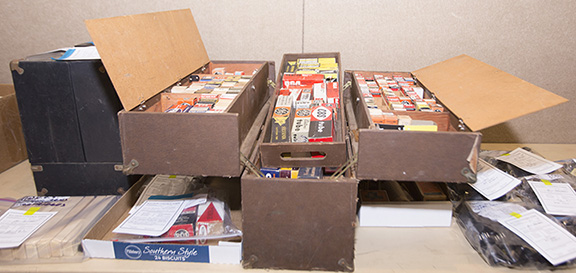
This TV repairman’s caddy of tubes generated the fiercest bidding, particularly among bidders with longtime eBay stores specializing in vacuum tubes. The worn nondescript brown vinyl-covered wood suitcase, 16" high x 8½" wide x 24" deep, contains foldout lids with compartmentalized shelves and removable center drawers crammed to the brim with uncataloged boxed tubes. Oklahoma collector Walt Murray took a huge risk with a final price of $787.50. He admitted, “I didn’t know if the tubes were good.” The risk paid off. Within 12 days, he had tested and resold the three most valuable—Western Electric 422A, typically used in new, very expensive amplifiers—as a pair and as a single tube—through his eBay store (http://stores.ebay.com/elderly-electronics) to a New York customer with an Asian name and one in South Korea for a total of $1380. Deducting for shipping, insurance, and fees, he made a 56% profit on his risky venture. Chirag Sainju photo.
The risk paid off. Within 12 days he had tested and resold the three most valuable—Western Electric 422A typically used in new, very expensive amplifiers—as a pair and as a single tube—through his eBay store (http://stores.ebay.com/elderly-electronics) to a New York customer with an Asian name and one in South Korea for a total of $1380. Deducting for shipping, insurance, and fees, he made a 56% profit on his risky venture.
Tubes proved popular auction items. A never-used working 1919 AudioTron tube for signal detection or amplification replete with original label and packing sold at wholesale price. Despite its rarity, the single AudioTron went for a low $157.50—the minimum on the seller’s auction form—rather than the expected $200.
Another applause getter was a 1938 novelty Charlie McCarthy radio. This very desirable ivory-painted Bakelite radio made by Majestic Radio & Television Company celebrated the popular dummy of ventriloquist Edgar Bergen from the age of enduring radio serials. Spirited bidding for this regal radio climbed to $682.50. Auctioneer Jim Sargent observed, “They went for $1000 ten years ago.”
Another applause winner—a difficult-to-find Zenith console Model 15U269—proved auctioneer Jim Sargent’s adage, “A good radio brings good money.” From Zenith’s 1938 line—the pinnacle year of Zenith desirability—the much-prized 15-tube radio was marketed for the black Robot Dial or Shutterdial, a control knob by which users could change from standard AM broadcast to domestic or foreign short wave bands as the dial exposed or covered the chosen station bandwidths. This rare console came from Kansas collector Paul Winans, who, at 92, was deaccessioning his collection.

The difficult-to-find Zenith console Model 15U269 (43" high x 26" wide x 15" deep)—proved auctioneer Jim Sargent’s adage, “A good radio brings good money.” From Zenith’s 1938 line, the pinnacle year of Zenith desirability, the much-prized 15-tube radio was marketed for the black Robot Dial or Shutterdial, a control knob by which users could change from standard AM broadcast to domestic or foreign shortwave bands as the dial exposed or covered the chosen station bandwidths. Promos also advertised its motorized tuning that allowed you to switch the dial pointer from one side of the broadcast spectrum to the other and then finesse the tuning by hand. This rare console came from Kansas collector Paul Winans, who, at 92, was deaccessioning his collection. Housed in a stately cabinet of varied walnut finishes under a replaced top, the nonworking Zenith console with matching pillar sides and bookend matching veneers is decorated with a tear-shaped brass escutcheon around the well-advertised Robot Dial. For years, this particular model had eluded Kansas Zenith console collector Bob Lutz. At its inception, few could afford an expensive 15-tube model; few sold, and even fewer remain today. A working fully restored model had gone for $1825 on eBay the previous month. That Saturday, Lutz placed the winning bid—$577.50. “I got a bargain [price] for something I wanted.” Chirag Sainju photo.
Housed in a stately cabinet of varied walnut finishes under a replaced top, the nonworking Zenith console with matching pillar sides and bookend matching veneers was decorated with a tear-shaped brass escutcheon around the well-advertised Robot Dial. For years, this particular model had eluded Kansas Zenith console collector Bob Lutz. At its inception, few could afford an expensive 15-tube model; few sold, and even fewer remain today. Lutz placed the winning bid—$577.50. “I got a bargain [price] for something I wanted,” he said.
“It’s supply and demand,” said auctioneer Sargent. “And the demand wasn’t there for the console.”
Collectors of important periods in radio development found worthy purchases for their collections from the start of home radio almost a century ago through the sought-after Art Deco era on through to the groundbreaking transistor radio.
One of the first complete radio sets available for home use or amateurs, the 1921 battery-operated Kennedy Model 281 has a reputation as one of the best-built shortwave radios from the early 1920s. Bidding on this home-friendly radio stopped on the low side of the seller’s $250 to $350 expectations at $283.50.

One of the first complete radio sets available for home use or amateurs, the 1921 battery-operated Kennedy Model 281 in a mahogany cabinet with a hinged lid, 7½" high x 18" wide x 7" deep, had a reputation as one of the best-built shortwave radios from the early 1920s. This home-friendly radio gave listeners three large tuning dials, a voltage control, outputs for headphones, posts to hook up a ground wire and two differing length antennae, top tap switches for fine signal tuning, and a convenient round mesh window for tube filament visibility to monitor the radio’s operation. Bidding stopped on the low side of the seller’s $250 to $350 expectations at $283.50. Chirag Sainju photo.
Styled like no other radio of its day, the luxurious early battery-operated Grebe Synchrophase Model MU-1 Tube Radio Receiver was built during the 1920s broadcast boom for homes. This Grebe came without tubes and with the seller’s warning, “Condition unknown.” Still, Oklahoma collector Jim Collings paid $142.50—nearly five times the seller’s minimum—or slightly less than its original $155 price tag almost a century ago. Though owning a later version, he was captivated by its eye-catching styling and very desirable original paper documentation.
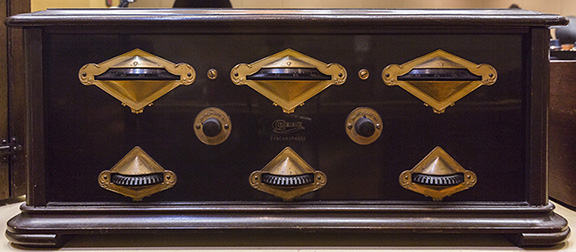
Styled like no other radio of its day, the luxurious early battery-operated Grebe Synchrophase Model MU-1 Tube Radio Receiver, 9½" high x 23½" wide x 13½" deep, was built during the 1920s broadcast boom for homes. Grebe mounted its tuning condensers in an unusual face-up position with horizontal “on edge” dials surrounded by 24k gold-covered and lacquered diamond-shaped escutcheons. The striking dials against the faux-grained dark red mahogany Bakelite panel exuded an Oriental effect. Later versions had “chain-coupled” dials that turned as one, but earlier ones like this one, manufactured 1924-25, with individual turning tuning dials, were sometimes referred to as “No Chains.”
This Grebe came without tubes and with the seller’s warning, “Condition unknown.” Still, Oklahoma collector Jim Collings paid $142.50—nearly five times the seller’s minimum—or slightly less than its original $155 price tag almost a century ago. Though owning a later version, he was captivated by the early 1924-25 machine’s eye-catching styling and very desirable original paper documentation—an oft-missing bottom manufacturer’s tag, interior case label and instructions, and accompanying advertising brochure. A similar model in need of repair sold for double the price—$315—on eBay the very next month. Chirag Sainju photo.
Not surprising, a 1931 elegant tabletop cathedral radio came up for auction. Popular during the Depression because of its affordability, the eight-tube RCA Victor Cathedral cabinet holds a Model R-7 radio chassis. With the seller’s tag noting “Condition unknown” and “static,” the RCA Victor Cathedral radio garnered a final bid of $105.
Texas collector Billy Smith put a 1930s grandfather clock radio on his wish list after seeing one at another collector’s home. “They’re really neat looking,” Smith said. So when the Philco Model 570 clock with a Model 71 radio chassis came up for sale, his wife, Sally Wilson Smith, who was sitting beside him, grabbed her husband’s bidding card and kept raising it till she had secured the clock radio for a wedding anniversary present. She got the unrestored clock radio for a steal—$168.
On Saturday, a similar Philco grandfather clock radio with a finial intact and much better original finish sold for $325.50—almost twice what Smith had paid. “At this auction, typically items don’t bring as much on Friday as they do on Saturday,” observed a veteran VRPS seller.
Several contested auction items exemplified a dominant collectors’ preference for the bold geometric designs of Art Deco, the visual arts style that flourished in the 1920s, ’30s, and ’40s and waned after WWII.
A black working 1937 Admiral Bakelite radio Model 5Z, submitted by a seller who had sold off most of his Art Deco radio collection, caught bidders’ eyes with striking chrome columns and twin chevrons that divided the geometric-patterned grill cloth. Repetitive, boldly delineated design elements accented the grill and dial. As a novel feature, the set could be used horizontally or vertically because the dial could be read from either position. Bids reached $178.50—twice what the seller anticipated.
After nearly three-quarters of a century, a shiny chocolate Bakelite rounded rectangular Coronado cabinet with distinctive “sunburst” dial circled by Art Deco radiating orbits amazingly showed no cracks. Even its usually missing metal back was intact. An attractive smaller tabletop radio, the 1942 Coronado “Jewel” Model C5D14 AC-operated tube radio was sold as the house brand through Gamble department stores for home use.
Buyers rewarded the uncommonly perfect WWII radio that, according to the seller’s tag, “played like new” with a $115.50 final sale price.
Art Deco’s decorative appeal influenced other sales. A round-edged rectangular 1953 Bakelite Art Deco working Crosley Dashboard clock radio Model D-25WE, styled like a mid-1950s car front panel, had eye-catching metallic gold trim around the protruding dials and knobs. The manufacturer’s emblematic “C” is emblazoned on its reddish-salmon crest between the dials. On the bottom, a varnished original Crosley label showed the vacuum tube layout, types, and power ratings. It incorporates a side socket for a coffeepot that could be preset to turn on by the clock’s alarm. Despite this unusual feature, its common ivory color depressed the final price to $84. The wife of Texas collector Anthony Quinn, who admires the Crosley design, was delighted to add it to her family’s radio collection.
Decorative appeal also figured into the bidding for smaller, more portable mid-1950s radios that incorporated transistor technology into the radio market. A prized early ivory 1956 Zenith Royal 500 transistor radio accompanied by the original saddle-colored pocket-size leather carrying case stamped with the Zenith logo sold for $42. Scarcer colors affect price.
Radio-related ephemera also sold. A rarely seen 1921 8¼" decorated plate, titled “Voices of the Night,” issued by the Farmers Mercantile in Chula, Missouri, satirized the newly invented radio and the marital disruptions it created with better night reception. A bidder got the commemorative plate, issued soon after the first radio station went on the air, for $31.50.
A small box of well-preserved pre-1924 novels marketed to young boys fascinated with the new radio technology was scooped up by Oklahoma collector Walt Murray. The nine“Radio Boys” books from three series put out by rival U.S. companies during the 1920s normally sell for $10 each, but Murray got the box for $31.50. “I wouldn’t let mine go for that,” said auctioneer Jim Sargent, who owns a set of 30. “But not everybody collects them, which is the reason for the low sale price.” Murray took them home for his wife to read and resell on eBay.
Collectors who specialize in pre-1926 radios need speakers to amplify their radio volume for group listening. The auction offered several choices for their collections or resale.
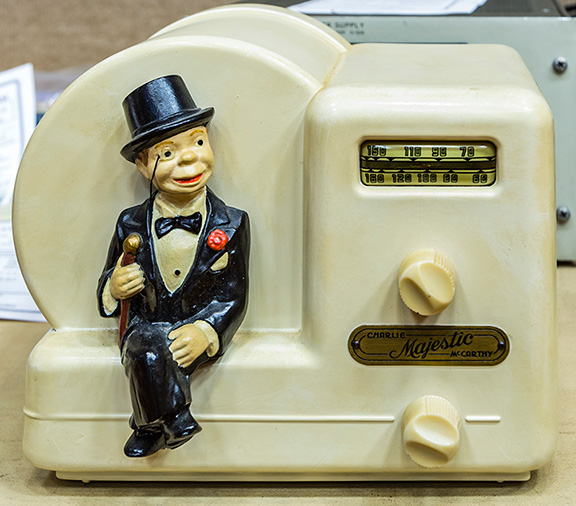
Another applause getter was the 1938 novelty Charlie McCarthy radio, 6½" high x 7" wide x 6½"deep. This very desirable ivory-painted Bakelite radio made by Majestic Radio & Television Company celebrated the popular dummy of ventriloquist Edgar Bergen from the age of enduring radio serials. From the mid-1930s to the mid-1950s, Bergen and his sidekick were on the air as a segment or with their own show, The Charlie McCarthy Show,till television lured away advertisers. Debonairly dressed like Fred Astaire in the 1935 film Top Hat,the lifelike Charlie McCarthy figurine sports a sophisticated black top hat, tuxedo, bow tie, monocle, boutonniere, and requisite cane. He sits, legs crossed, commanding his fans from a cylindrical cocktail lounge banquette beside the radio dial and control knobs. Spirited bidding for this regal radio, advertised with the slogan “Majestic CHARLIE MCCARTHY! THE 2 MIGHTY MONARCHS OF THE AIR!,” climbed to $682.50. Auctioneer Jim Sargent observed, “They went for $1000 ten years ago.” Chirag Sainju photo.
“It’s the best buy I made,” said Oklahoman Jim Collings, a top eBay dealer for vintage radio equipment (http://stores.ebay.com/JRCRADIO-Tubes-Parts-Music-Phono), the first day of the VRPS auction. He had purchased a 1921 bell-shaped horn speaker. It displayed an elegant tapered neck fashioned of composite paper locked on a circular black enamel-painted brass base. Most importantly, the horn showcased the label of the premier 1920s manufacturer, Western Electric, on its base. The company made the Model 518-W speaker specifically for the Model 7A amplifier for use with a PA system or other commercial purposes. Collings expected to resell it on eBay for $200 or roughly four times his purchase price of $47.25. Alas, that wasn’t the case. It had a starting price of $9.99, and an eBay bidder bought it for $129.50.
Collings also snared a nonworking gigantic 1922 Magnavox Type R2, Model C Telemegafone painted brass horn speaker built for use with radios or PA systems for $189.
Sometimes final bids far exceeded sellers’ minimums. A 1925 cast-iron Vitalitone nautical motif cone speaker carried a seller’s $20 minimum. The imposing 16" diameter speaker displayed a rich brown chainlink border encircling a raised frieze showing a ship. The seller’s tag attested it “works well” and possessed a “good driver.” Its reproduction paper cone did not impede buyers from raising the price to $157.50—seven times its minimum.
Like speakers, period amplifiers commanded their share of the bidding. Collectors sought decades-old external amplifiers used for public spaces or the more powerful, less distorting external amplifiers that emerged with the advent of high-fidelity sound. A 1933 International Projector Corporation Model NP5 amplifier made by Electro Acoustic Products Company for movie theater use was cased in a shiny black enamel-painted steel cabinet. The VRPS buyer paid $105 and then resold it on eBay three weeks later for $598. When the eBay customer complained that the power transformer was bad, the seller gave a substantial price reduction instead of accepting a return.
The quest for better sound that paved the way for 33 rpm long-playing records, tape-recorded sound, and high-fidelity broadcasting on the FM band also prompted manufacturers like Bell Sound Systems Inc. to produce huge numbers of amplifiers, including the low-end entry-level 1958 Bell Model 2122 Hi-Fidelity Amplifier, to satisfy market demand.
A dark maroon-painted steel AC-powered amplifier with ten-watt output can connect to a turntable and an AM/FM radio tuner or with another amplifier create a stereo system. It sold for $52.50 to downsizing Texas collector Michael Hagan, who could not resist the collectible piece, he said, “because of the name Bell as a manufacturer, its good physical condition, and attractive cosmetics.”
Cylinder and flat platter phonographs at the auction hailed from the heyday of this home entertainment machine in the early 20th century.
Renowned inventor Thomas Edison designed the compact, portable windup Fireside Model A cylinder phonograph introduced in 1909 as one of the first to play two- and four-minute cylinders. A Texas collector who had long wanted an old-time windup phonograph with external horn bought an unrestored Edison cylinder phonograph accompanied by four Edison cylinders but lacking a horn for $220.50.
The auction also showcased a 1915 spring-powered cylinder phonograph whose genre lost out to the platter playing phonographs we know today because of the convenience of record storage. Texas collector Mike Grimes purchased it in a large Texas collection he acquired with a partner in September 2015.
The classic windup Edison Amberola 30 cylinder-playing phonograph in a fine grained oak case with lift-up lid with a banner-size gold-scripted Edison logo on its interior came with original and reproduced documentation. Potential buyers could play five music cylinders, one of which included the WWI British anthem “It’s a Long Way to Tipperary.” It sold for $252.

This classic windup Edison Amberola 30 cylinder-playing phonograph, 12" high x 12½" wide x 16" deep, with a fine grained oak case and lift-up lid with a banner-size gold-scripted Edison logo on its interior features a cylinder-playing mechanism controlled by a side crank and a black pot metal lacquered 1917 reproducer. Decorative vertical oak-grained metal slats cover the front speaker. Amazingly enough, it came with original and reproduced documentation—instructions, advertising brochure, and parts list from over a century ago. Potential buyers could play five music cylinders, one of which included the WWI British anthem “It’s a Long Way to Tipperary.” It sold for $252. Brigitte Zumaya photo.
Early televisions also appeared at the auction but sold at depressed prices. Texas collector Michael Hagan explained, “Before digital TV transmitted via cable, telephone, or dish, vintage TVs were worth a lot more to collectors because they could use them with signal reception from the air. Now they need a converter, and it doesn’t always work. So the market for post-WWII sets has fallen out, except for the extremely collectible first color sets.”
The sets auctioned illustrated Hagan’s savvy market analysis. A handsome 1948 burnt sienna Model 7VT5RA Motorola portable suitcase TV, which could be carried to any room in the house, normally sells for at least $80. It is built into a leatherette case, and the TV’s snap-shut lid protects the 7" cathode-ray tube screen in transit and offers convenient holders for transporting the TV’s “rabbit ears” antenna and rotating circular base. It was bought by a Texas collector for a $47.25 bargain price to use, a friend said, “as trade bait to talk someone into giving him something he really wanted.”
One of millions of sets manufactured from the late 1940s to the mid-1960s, a 1957 14" black-and-white RCA Victor TV Model 14-S-7073G was found by the seller at a local garage sale. With an arresting burnished red rectangular case accented by chevrons and golden bronze trim, the TV boasted a saddle-colored reproduction leather strap secured in the center for portability. Since this over half-century-old TV did not work, it went for $36.75.
Sixteen percent or a total 167 items brought up for auction didn’t sell either because of high minimums, space requirements, condition issues, or lack of interest.
A $200 minimum tamped down interest in an unblemished working windup 1915 acoustical Victor Talking Machine Company Victrola Model VV-Vl. The 100-year-old tabletop Victrola had the typical Victor exhibition reproducer of the day. The needle attached to the reproducer (known as the “sound box”) transformed the record’s impressed grooves into audible sound through the nickel-plated tone arm with the help of an internal horn. The record platter sat atop a lovely grained quartersawn oak cabinet above tidy levered double doors that opened to reveal decorative horizontal oak slats extending from the internal horn. The doors actually served as volume controls. Not even a record by premier ’20s dance band Paul Whiteman and His Orchestra, replete with the bandleader’s “potato head” headshot gracing the record platter, could induce history buffs to bid.
The $200 minimum discouraged bidders for a WWI Boston-style marble-based, nickel-plated, spring-operated Spark telegraph key. The key with no brand label had been bought for $150 on eBay. Early keys for sending Morse code like this lacked dust covers over the large, dime-size contact to prevent escaping sparks from starting fires during transmission of telegraph signals. The key’s brass showed through the nickel plating everywhere from wear. Unable to sell the worn key for profit, the seller happily kept it because he didn’t have an early key like this in his collection.
In a first for the Vintage Radio and Phonograph Society, auction assistants used a wireless video device instead of a camera tethered by a cable to project large, heavy auction items on the front projection screen. So with this device a screen image appeared of a gorgeous double-door, six-legged Stewart Warner 1936 Model R-138-A console with carved leaf top and original finish. The beautifully grained walnut, brass-knobbed doors opened to display a very desirable tuning indicator called the “magic eye,” a brass escutcheoned station dial, tuning knobs, and wood slats forming long side and center Gothic arches over a patterned grill cloth. The “magic eye” tuning indicator turned completely green with perfect station alignment.
Seller Kenny Black’s auction form assured potential buyers that the nearly 80-year-old 12-tube radio bought from its original owner not only “works well,” but possesses two “very good” 2A3 premier output tubes. A receipt from its last repair in 1944 showing replacement of tubes and its transformer costing $8.72 was available for inspection. But buyers passed on this knockout console either because of unavailable home space to quarter it or because of its reasonable $300 minimum.
A $40 minimum discouraged bidding on an early 1960s 12" tall highly polished chrome-plated steel Astatic “Lollipop” microphone Model D-104 with a 5½" base and rugged T-UG8 stand. The seller’s tag did not reveal whether it operated. A bystander said, “It would have been worth $40 if it worked. Nobody wanted to take the risk.”
But a historic working mike with no minimum did sell—for a bargain price. A 1934 Universal Model XX double button carbon ring mike designed to pick up sound from either side for easy use with an amplifier for public performance or public address system won bidder interest despite its unknown condition. Steadied by a 3¾" reproduction circular stand and 4½" generic metal ring, the authentic early 2½" mike was suspended in the ring by springs to reduce vibration and ambient noise.
At the start of the bidding, Nebraska collector Randy Buss raised his hand and left it there. “I didn’t have a mike like it, and it really looked interesting.” Buss, a novelty radio collector, added, “I like new and different things.” He took home the mike for $63 and with a volt meter discovered it worked.
Collectors are already planning their vacations around the next Vintage Radio and Phonograph Society auction scheduled for March and the annual pre-Thanksgiving convention auction the third week in November. For more information, see the VRPS website (www.vrps.org) for details.
Record Setters from the Vintage Tube Era
by Barbara Kevles
Mid-1950s, the explosion of the portable, popular transistor radios, manufactured in the billions in the 1960s and 1970s, not only made tube machines obsolete, but triggered nostalgia for their rich mellow sound. Serious collecting of vintage radios and related items began in the late 1960s as people remembered their childhoods and their grandparents’ homes. In upstate New York, the Antique Wireless Association developed around ham operators interested in collecting old equipment and quickly morphed into an international organization. This collectible area gained momentum in the ’70s from the nationwide proliferation of clubs dedicated to preservation and restoration of antique radios and phonographs, the 1985 five-part PBS series “Radio Collector,” and the yearly Marshalltown, Iowa, vintage radio auctions.
In 1990, Richard Estes pioneered the monthly commercial auction devoted exclusively to wireless radios, early phonographs, tube collections, related equipment, ephemera, and coin-operated machines. His entrepreneurial business acumen paid off. Estes served as auctioneer of the two-day, once-in-a-lifetime Henry Ford Museum Radio Auction, and Estes Auctions ran the three-day $1 million legendary sale of the famed Ralph W. Muchow estate. In 1995, the launch of eBay expanded the availability and customer base for this field of collectibles in the U.S. and internationally exponentially.
As far as we know, these are the record setters in this field.
In 2010, a Buffalo, New York, dealer sold one of the few fully restored examples of the first user-selected, coin-operated multicylinder phonograph for $135,000 in a private sale. In its day, the Multiphone Operating Company placed these fancy 1908 precursors of the modern electronic jukebox in high-end hotels and restaurants for entertainment of their posh clientele. The over 7' tall ornately hand-carved lyre-shaped mahogany case—the focus point of any lobby—would invite patrons to crank up the machine, drop a nickel in a slot, choose from 24 catchy popular songs, marches, and waltzes, and watch through a beveled oval glass as the machine chose their selection from a mechanically automated carousel of cylinders to play. Five years later in December 2015, an identical machine was listed on eBay with a lower $93,500 “Buy It Now” price and later removed.
A midwestern collector paid a record $14,500 for an extremely rare single pre-WWI 1' tall vacuum tube from the estate of Sanford Deutsch of Yorktown Heights, New York, on September 20, 2003, at Estes Auctions. The German-made clear glass LRS relay tube invented by Austrian physicist Robert von Lieben to repeat telephone signals in transit was uniquely shaped. An unusual spiral-topped filament descends in double spheres forming a circle of multiple Ms before attaching to a metal base. “It’s very early for a vacuum tube, and few tubes survived from this era,” said the purchaser.
In 2006, Estes Auctions received its highest bid ever for a radio—$73,500—for a Zenith Stratosphere Model 1000Z, one of the world’s most sought-after radios. One of the larger consoles of its day, this limited-edition opulent Art Deco-styled 25-tube radio originally retailed at $750 during the Great Depression. It innovated a recessed speaker alcove for enhanced acoustics and covered dials and knobs with sliding doors of rare exotic woods in an appeal to women. It featured a revolutionary 9" black airplane dial with shadowgraph tuning meter to fine tune stations on its five bands and a unique assembly of high-end components for the highest sound fidelity.
Oklahoman top vintage tube era dealer Jim Collings found the most expensive pair of speakers sold to date under a stove in a bucket in a cow barn of a Kansas farmer. Collings stuck his hand in a washtub of hay and mud and miraculously pulled out the 1930s short cylinder-shaped Western Electric 597A field coil tweeters with attached horns that were so perfect for the limited wavelengths of high-end frequencies. He paid $500 for the pair. Then on June 5, 2007, he sold the pair on eBay to a South Korean for $21,166.
In the 2001 Ralph W. Muchow estate auction one-of-a-kind radio advertising pieces went for astronomical prices—11 sold for over $1000 each. A beautiful full-length, 4' x 8', 1930s wall tapestry advertising a high-end radio manufacturer received a record $2600 final bid. The banner-size slogan proclaims “THERE IS NOTHING FINER THAN A Stromberg-Carlson” above a mythical lyre nestled on a tri-leaf corsage against a royal Venetian red background. The bottom half remains largely vacant for the sine qua non—the dealer table display.
In 2011, Bob Paquette, founder of the Wisconsin-based Bob Paquette Microphone Museum, devoted to the microphone’s history till 1950, privately sold an extra coveted 1949 Neumann switchable cardioid and omnidirectional U47 tube condenser microphone and an extra switchable 1949 cardioid and figure-8 pattern U48 tube condenser microphone—both distributed by Telefunken—with the original power supplies and cables to a local recording studio for a record price of $15,000 each.
EBay captured the highest price paid for a pair of amplifiers sold in recent history. In October 2015 a bidder paid $13,688.76 for ultra-rare completely serviced Western Electric 124B monoblock amplifiers ready to plug and play for stereo. They dated from the high-fidelity era; commercial radio stations used these 1955 amplifiers to listen to playbacks of transmitting broadcasts. Replacement tubes didn’t prevent bidders from bidding $1000 increments for the very desirable Western Electric amplifiers.
In May 2008, an East Coast TV collector paid the Dave Johnson estate a record $50,000 for a historic, rare 1936 RCA Model RR-359B—one of the first prototype television receivers for viewing by more than one person. An upright picture tube nearly as tall as the 42" walnut cabinet projected a 441-line picture on the tube’s 12" screen reflected in the interior lid’s mirror that was tilted at an angle for group viewing of experimental broadcasting. It was used to field test terrain’s effect on pictures received. In the spring of 2015, an identical museum piece couldn’t make its $35,000 asking price. Recalling the price he paid, the collector said, “I don’t know [whether] to be proud of it or ashamed of it, if prices keep going down.”
In the current economy, the general market for tube-era collectibles is suffering, but vintage components used for high-fidelity equipment appear to be immune to these trends.
Originally published in the March 2016 issue of Maine Antique Digest. © 2016 Maine Antique Digest


